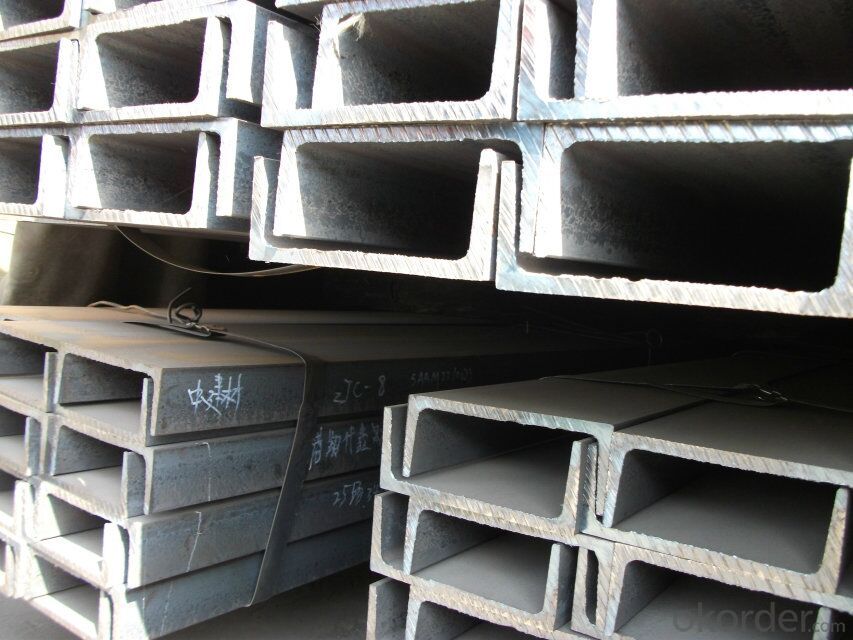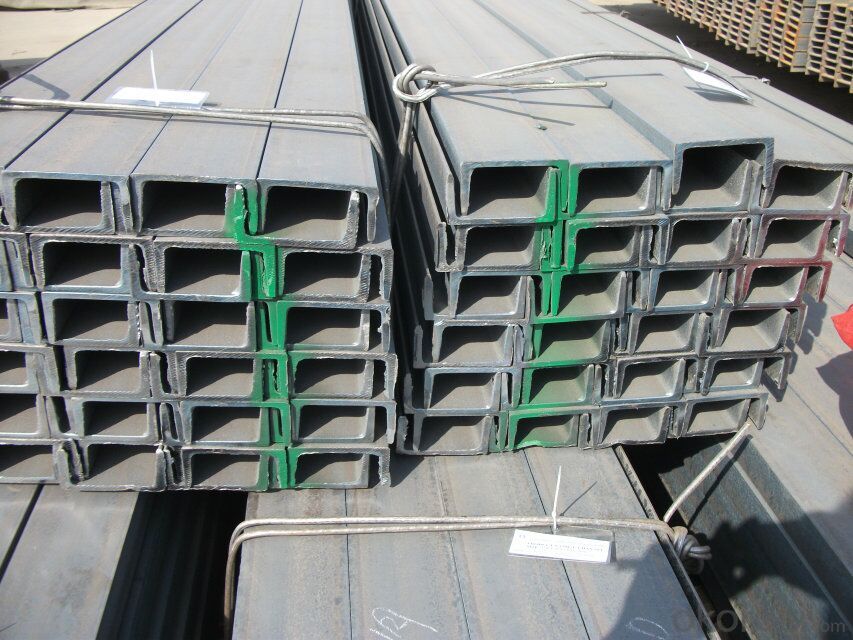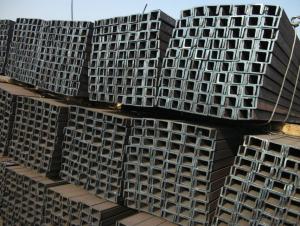Supply JIS Standard U Channel Steel in Sale
- Loading Port:
- Tianjin
- Payment Terms:
- TT OR LC
- Min Order Qty:
- 25 m.t.
- Supply Capability:
- 5000 m.t./month
OKorder Service Pledge
OKorder Financial Service
You Might Also Like
Item specifice
high quality Hot Rolled Steel U Beam at great prices with worldwide shipping. Our supplier is a world-class manufacturer of steel, with our products utilized the world over. OKorder annually supplies products to European, North American and Asian markets. We provide quotations within 24 hours of receiving an inquiry and guarantee competitive prices.
We supply high quality MS Channel at reasonable price, including Chinese standard, Japanese standard and so on.
Standard | GB/JIS |
Material Grade | Q235,SS400 |
Technique: | Hot Rolled |
Sizes as per chinese standard: | 50*37*4.5mm - 300*89*11.5mm |
Sizes as per japanese standard: | 50*25*3mm – 200*80*7.5mm |
Length: | 6meter, 9meter, 12meter |
Product Applications:
Hot Rolled Steel U-Beams are ideal for structural applications and are widely used in the construction of buildings and bridges, and the manufacturing, petrochemical, and transportation industries.
Product Advantages:
OKorder's Steel U-Beams are durable, strong, and resist corrosion.
Main Product Features:
· Premium quality
· Prompt delivery & seaworthy packing (30 days after receiving deposit)
· Corrosion resistance
· Can be recycled and reused
· Mill test certification
· Professional Service
· Competitive pricing
Product Specifications:
Manufacture: Hot rolled
Grade: Q195 – 235
Certificates: ISO, SGS, BV, CIQ
Length: 6m – 12m, as per customer request
Packaging: Export packing, nude packing, bundled


- Q:Which kind of wind resistance is better for square tube, square tube or channel steel?
- Square pipe and channel steel that load-bearing better 1, the same thickness and area, square superior to channel. 2, if the channel is closed to a rectangular tube, then the channel is better than the square tube.
- Q:What is the difference between C steel, U steel and channel steel?
- U type steel (hot rolled U steel mine roadway Name: U steel) is English steel like the letter "U" with a cross section, sometimes with a cross section of Japanese letters "better" shape. Main features: large pressure, long support time, easy installation, not easy to deformation and so on. Main uses: mainly used in mine roadway, roadway support, and two times of the tunnel supporting etc.. As the main shape steel for the retractable metal support of tunnel, U steel is widely used at home and abroad.
- Q:What is the lifespan of steel channels?
- The lifespan of steel channels can vary depending on various factors such as the quality of the steel, the environmental conditions it is exposed to, and the level of maintenance it receives. Generally, steel channels have a long lifespan and are known for their durability and strength. With proper maintenance and regular inspections, steel channels can last for several decades or even longer. However, factors such as corrosion and wear and tear over time can affect their lifespan. It is important to protect steel channels from moisture and corrosive substances to prolong their lifespan. Additionally, regular inspections and maintenance can help identify any signs of damage or deterioration early on, allowing for timely repairs or replacements to ensure the longevity of the steel channels.
- Q:What are the different testing methods for steel channels?
- There are several testing methods for steel channels, including visual inspection, dimensional measurement, ultrasonic testing, magnetic particle testing, and load testing. Visual inspection involves examining the surface of the channel for any visible defects or irregularities. Dimensional measurement ensures that the channel meets the specified dimensions. Ultrasonic testing uses high-frequency sound waves to detect internal defects such as cracks or voids. Magnetic particle testing utilizes magnetic fields and iron particles to identify surface cracks or discontinuities. Load testing involves applying a known load to the channel to evaluate its strength and deformation characteristics.
- Q:Channel steel is a strip of steel with a cross section.
- The box is denoted by 12# (H) * leg width (b) * waist thickness (d), such as 120*53*5, which means that the waist height is 120 mm, the width of the leg is 53 mm, and the channel is 5 mm thick, or called channel steel. The same height of the channel, if there are several different leg width and waist thickness, also need to add a, B, C on the right side of the model to distinguish, such as 25a#, 25b#, 25c# and so on
- Q:What are the different shapes of steel channels?
- Steel channels come in various shapes and sizes to cater to different structural and construction needs. Some of the common shapes of steel channels include: 1. C Channel: Also known as a C-shaped channel, it has a straight back and two perpendicular legs. This shape provides excellent structural support and is commonly used in building frames, supports, and industrial applications. 2. U Channel: Similar to the C channel, the U channel features a straight back and two parallel legs. It is often used as a support for building structures, trailers, and vehicles. 3. Hat Channel: This type of steel channel has a wide flat top resembling a hat, with two legs extending downwards at an angle. Hat channels are commonly used for roofing and wall framing in residential and commercial construction. 4. Z Channel: The Z channel is shaped like the letter "Z," with one flange extending upwards and the other flange extending downwards. It is commonly used for purlins, studs, and in construction applications that require additional strength and stability. 5. Box Channel: Box channels have a rectangular shape with four sides of equal length. They are commonly used in construction projects that require structural support, such as for beams, frames, and trusses. These are just a few examples of the different shapes of steel channels available. The choice of shape depends on the specific application and structural requirements of the project.
- Q:How do steel channels compare to other structural shapes like beams and angles?
- Steel channels, beams, and angles are all commonly used structural shapes in construction and engineering. Each shape has its own unique properties and advantages. Steel channels are typically U-shaped and have a flat base and two perpendicular legs. They are often used for applications where strength and rigidity are important, such as supporting heavy loads or providing structural support in buildings. Compared to beams and angles, steel channels offer better resistance against bending and torsion due to their shape, making them suitable for long-span applications. Beams, on the other hand, are typically I-shaped and have a longer span compared to channels. They are commonly used in building frames and bridges, offering excellent load-bearing capacity and structural stability. Beams are often preferred when longer spans and larger loads need to be supported. Angles, as the name suggests, have an L-shaped cross-section and are commonly used for bracing, framing, and support structures. They are versatile and can be used in various applications, including reinforcement in concrete structures or as support brackets. Angles provide good strength and stability in applications where vertical and horizontal forces need to be resisted. In summary, steel channels, beams, and angles each have their own unique characteristics and advantages. Steel channels are ideal for applications requiring resistance against bending and torsion, while beams are preferred for longer spans and larger loads. Angles are versatile and can be used in various applications requiring strength and stability. The choice between these structural shapes depends on the specific requirements and design considerations of the project at hand.
- Q:Can steel channels be used in high-temperature environments?
- Certainly! Steel channels are capable of being utilized in environments with high temperatures. Steel, being a material that is both highly durable and resistant to heat, is able to endure high temperatures without compromising its structural integrity. It possesses a high melting point and is not easily deformed or weakened when subjected to extreme heat conditions. In industrial settings, steel channels are frequently employed in applications including furnaces, boilers, and equipment for high-temperature processing. Nonetheless, it is crucial to carefully consider the specific grade of steel being employed, as certain types may have restrictions in terms of their ability to resist high temperatures. Moreover, one must also take into account factors such as the duration and frequency of exposure to high temperatures when assessing the suitability of steel channels for a particular high-temperature environment.
- Q:Do steel channels have any specific deflection limitations?
- Yes, steel channels do have specific deflection limitations. The deflection of any structural member, including steel channels, is determined by factors such as the material properties, dimensions, and the applied loads. The maximum allowable deflection for steel channels is typically specified in building codes and industry standards. These limitations are based on the criteria of serviceability, which ensure that the structure remains functional and safe under normal operating conditions. The deflection limits for steel channels vary depending on the specific application and loading conditions. For example, in structural steel design, the deflection limits for beams and columns are typically based on the span-to-depth ratio or a maximum allowable deflection value. In addition to code requirements, engineers also consider the intended use, aesthetics, and occupant comfort when determining deflection limitations. For instance, in buildings where vibrations or excessive deflections could impact sensitive equipment or occupant comfort, stricter deflection criteria may be applied. It is important to consult the relevant building codes, industry standards, and engineering guidelines to determine the specific deflection limitations for steel channels in a given application. Professional structural engineers are responsible for ensuring that the design meets these requirements to ensure the safety and performance of the structure.
- Q:Can steel channels be used in railway infrastructure projects?
- Certainly! Steel channels have a significant role to play in railway infrastructure projects. They find widespread use in the construction and maintenance of railway tracks, bridges, and other structures. Their inherent strength, stability, and durability make them ideal for bearing heavy loads and enduring the continuous movement and vibrations associated with railway operations. In the realm of railway infrastructure, steel channels serve multiple purposes, such as providing support for the rails, fabricating track sleepers, reinforcing bridges and tunnels, and erecting safety barriers and fencing. Moreover, steel channels can be tailored to meet specific project requirements in terms of size, shape, and material composition, thereby further augmenting their suitability for railway infrastructure projects.
1. Manufacturer Overview |
|
|---|---|
| Location | |
| Year Established | |
| Annual Output Value | |
| Main Markets | |
| Company Certifications | |
2. Manufacturer Certificates |
|
|---|---|
| a) Certification Name | |
| Range | |
| Reference | |
| Validity Period | |
3. Manufacturer Capability |
|
|---|---|
| a)Trade Capacity | |
| Nearest Port | |
| Export Percentage | |
| No.of Employees in Trade Department | |
| Language Spoken: | |
| b)Factory Information | |
| Factory Size: | |
| No. of Production Lines | |
| Contract Manufacturing | |
| Product Price Range | |
Send your message to us
Supply JIS Standard U Channel Steel in Sale
- Loading Port:
- Tianjin
- Payment Terms:
- TT OR LC
- Min Order Qty:
- 25 m.t.
- Supply Capability:
- 5000 m.t./month
OKorder Service Pledge
OKorder Financial Service
Similar products
New products
Hot products
Related keywords





























